Stafford Street
|

The George Hotel. Wilcox's was next on the right. |
Next to the George pub was Wilcox's, the big rag and
bone market. It was a great big, dirty place. You took everything that
you didn't want, even rabbit skins.
Mr. Wilcox would come and take the
rabbit skin off you, check it, and say " two pence". If it was a good
one he would give you four pence. He could tell by the skin and the fur,
and I think they used to make coats out of them.
It was a tremendously
high place, dark with hardly any light coming in. The girls were
working, sorting the rags out. |
| You also used to take the old meat bones and old clothes. You might come
out with 5 pence or sixpence. |
| There was the drill hall . I've seen some things there
when I was a kid, that's because it was the main place in the town for
everything that was going on.
The soldiers would give their practising
hours up and they would put it on. It was a big area where everything
happened, dances and cinema shows. We used to go on a Saturday night and
see them come in their cars, with all of their glorious outfits on, all
sorts of concerts.
Even the Irish concerts, where they used to break
everything up on St Patrick's day. They would come in their horses and
traps, get off there and walk through a little canopy, down into the
main place at the bottom. There was a long corridor with all little
rooms down to the big hall, which was at the back. |
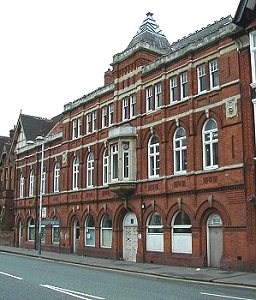
The Drill Hall offices. The hall, which was at the
back has been demolished. |

The Poor Hall.
In reality the Poor Law and Registry Office. |
The Poor Hall is the big house next to the old Drill
Hall, on the corner of Whitmore Street. Parents used to go there if they
were in poor financial circumstances and weren't getting any money from
their grown-up sons or daughters.
They had to go and be interviewed, and
how much they had to pay to their parents would be determined.
There's
been a lot of rows and bothers there with mothers, fathers, brothers and
sisters, because they might have to pay two bob a week to help keep
their parents. |
| The Co operative was on the other corner of Whitmore
Street. They didn't even have gas mantles, the burning flame came out like a
fan. The Hibernian was opposite, and on the corner of Charles Street was a
big chemist shop, called Bowdlers. |
| By the Hibernian was a big yard where Edwards used to
have their trucks and trolleys. You could hire them for moving your
house at 6d a day. They were those big flat trucks with laths across,
and two wheels and a handle. They would be about 8ft long and 6ft wide,
with two big spoked wheels with steel rims. You used to put your
furniture on that if you were thrown out, and go where you could, to the
next place.
That used to happen often and so they would go and hire a
trolley at 6d a day and put their furniture on, tie it on and off they
would go. |
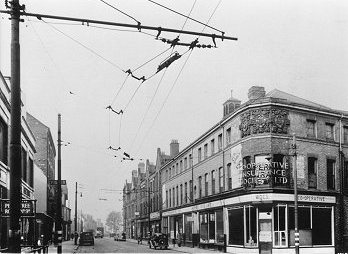
The Co op. on the corner of Whitmore Street. Photo courtesy of Eardley Lewis. |
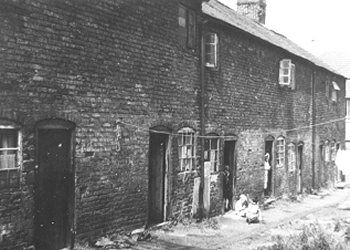
Crooked Lane. |
Crooked Lane came up to the side of the Britannia pub.
We used to go up there, there was Charles' Coal Wharf and a big pub at
the top of Lawyer's Field. Crooked Lane turned left then right and the
water used to run down the middle.
There were tiny houses, one room
houses with everything in the single room. Tables, chairs, washing tubs,
mangles, all in the one room.
The toilets were across the other side of
a 6ft wide alleyway, perhaps 3 or 4 toilets for 10 houses. There were no
water toilets in Crooked Lane. |
| Speake and Son, building contractors, was a great big
place at the top of Cam Street. On one side of the road was the workshop
and on the opposite side was their stores where all of the wood was.
On one side of the Cannock Road, was the Junction pub, with the Elephant
& Castle on the other side. The Elephant & Castle was a lovely thing,
they never should have knocked it down, it was terrible. The elephant
sign should have been kept, it had real gold on its back. |

Stafford Street, looking towards the Elephant &
Castle. Photo courtesy of Eardley Lewis. |
Macfarlane and Robinsons, the old enamel and earthenware
people, where behind the Elephant & Castle. They made big dishes, big trays,
gas plates and things like that. It was a big place, next to what we called
the cattle shunt and the big Co op. coal wharf. It caught fire, the biggest
fire in Wolverhampton at the time. I remember my dad when he came home from
his work at the Grand Theatre.
He finished work at 11 o'clock and saw the
fire on his way home. He went down the road and my mother was worried
because he didn't get in until about 4 o'clock in the morning. They had to
eventually take pipes down to the canal on the Cannock Road, which was under
the two railway bridges. They had to drain water from the canal, because it
was such a large fire that the fire engine couldn't cope.
After the fire,
Macfarlane and Robinsons moved to where Goodyears are. They built a new
place there and in later years it was taken over by Goodyears. A lot of the
local girls used to work at Macfarlanes, doing the enamelling, the dressing,
the painting. They always used white enamel with blue rims. Simmonds was
another one, they were up by us in Charles Street. They were not so big as
Macfarlanes and made a different type of earthenware, mainly small items. A
lot of girls worked there.
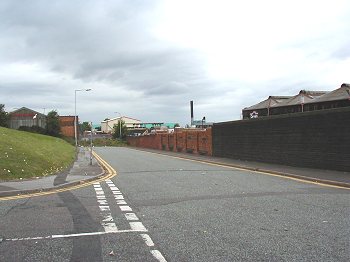
Great Western Street today. The Great Western
Railway goods yard buildings can be seen on the right. Today they are
occupied by Carvers builders merchants. |
On the corner of Nursery Street was Hills. It was one of
the biggest grocers in Wolverhampton. There was a big grocery stall and
big bins for wheat, corn and barley. They also had a building where they
kept their horse and cart. There were no houses down Wilson Street,
only one at the bottom, and it went down a little alley where the
stables of the Great Western Railway were.
They kept the horses for the
railway there. They used to go round what we called Chicken Hill, which
came out on the Cannock Road. |
| Herringtons the sign writers were also in Stafford Street.
They took a pub over as a house, and had their factory in Nursery Street,
where they did all of their sign writing, made their boards and that. I've
watched them doing it many times. |
| At the back of us in Herbert Street we had Garfield's
the stone mason. I used to love them chipping the letters for the
gravestones, by hand, with a great big mallet and little chisel.
I've
sat on the wall many times watching them. Next was Russell's Brewery. I
was allowed to go in there because they knew me and watch them steaming
the barrels and brewing the beer, and doing the malting with the hops.
It was a wonderful brewery. They had one of the finest milds in
Wolverhampton. |
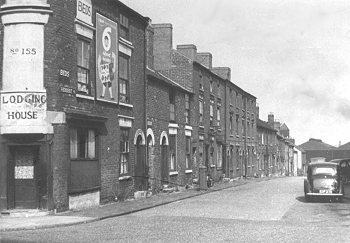
Herbert Street, where George lived. |
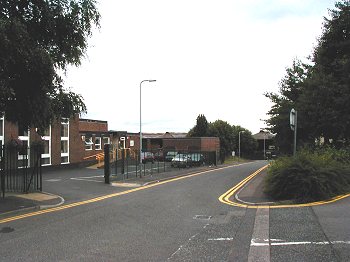
Herbert Street today. |
I think Russells were taken over by
somebody at Dudley. If I remember right, Butlers brewery was down
Grimstone Street and Springfield Road. Butlers, had the water from
Russell's well piped down to their brewery, it was such good water.
I
used to go to a place in Westbury Street, where they made toffee. The
house down below was a little dwelling house and they made toffee and
sold it in trays.
It was run by a women who made the toffee and sold it
herself. People also used to do pickled onions and things like that and
sell them in their fronts, you know. |
|
I used to go to the Olympia on a Saturday
afternoon, which was 2d for the afternoon. I used to call in to
Westbury Street, to the place where they made toffee. They used
to make it in aluminium trays and it was thick when it set.
You'd have a ha'peth of toffee
and they would wrap it in newspaper. They had stacks of old newspapers. It
was alright when it went into the newspaper, but when you had been in the
pictures and you got it out of your pocket, you couldn't undo the paper
because the toffee had melted.
Every Tuesday and Wednesday, they used to unload the cattle
for the cattle market, in Bilston Street, at the Great Western Railway Goods
Yard. They used to drive horses, cows and pigs up Stafford Street and
through the town. We used to call it the Cattle Shunt. On Wednesday, which
was market day, there would be cattle coming and going all day. The drovers
couldn't always control them, so sometimes the cattle would run wild. There
was a post office in Stafford Street and several times a cow had ended up in
there with its legs across the counter. It used to drive the woman in there
berserk. One day, George was knocked down by a sheep at the top of Broad
Street, by the tramlines.
Horses used to come up and down Herbert Street, from the
railway. At the back of us was the goods yard, you see, and the loading yard
for all of the merchandise that had to be sent into Wolverhampton, so the
horses and carts were coming up and down our street, every minute of the
day.
|
| A lot of houses had oil lamps, a table lamp or ceiling
lamp. You could pull the ceiling lamp down with a weight, light it and
it would go back up. It was balanced on a weight and you could push it
up as high or low as you liked. We had these paraffin lamps before we
had gas.
Nearly all of the shops sold paraffin, even food shops. That
was eventually condemned and they had to stop selling it. You could go
to any shop and get paraffin. They would have a little pump, pump it
into vessels, a quarter, half or one pint, and pour it into your
container. |

Another view of Stafford Street, looking towards
the Elephant & Castle. Photo courtesy of Eardley Lewis. |
We had a paraffin tin that you brought from
the market for 6d. Some people couldn't afford that and so they had it in
bottles, anything. In the food shops they would serve the paraffin, wipe
their hands on a cloth and serve the bread. The bread was not wrapped,
everything was loose, your parsnips, potatoes, or carrots. They were pulled
out of a basket and sold as a ha'penny or a pennies worth. There were a lot
of fires, because the kids used to upset the paraffin, or break the paraffin
bottle, when they were playing around the house. They used to store it in
old ginger beer bottles, all sorts of things.
The canal was filthy, all the boaties used to throw their
rubbish in the canal, they had no where else to put it. They used to throw
anything that they did not want into the water. Old bikes, old scooters, old
skates, all had to be thrown in the canal.. They did not clean them like
they do now. The kids used to go in swimming, they couldn't afford 2d to go
to the baths. They used to swim in Crown Street, under the two railway
bridges, where the sun used to shine. The police used to chase them
occasionally. There used to be anything between 20 and 30 kids in that
place, down by Crown Street. It was filthy and I never went in.
 |
|
 |
|

|
| Return to the
Beginning |
|
Return to
Daily Life |
|
Proceed to
George's Family |
|















